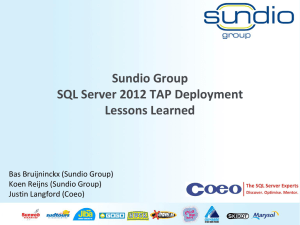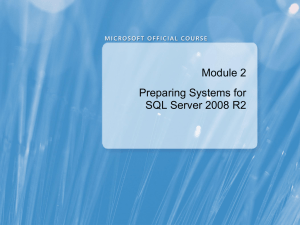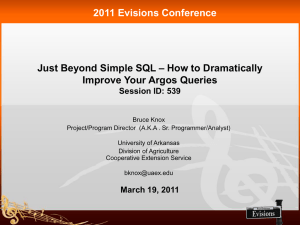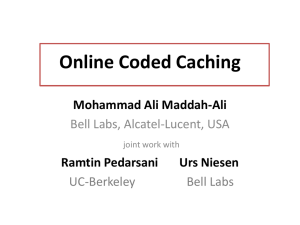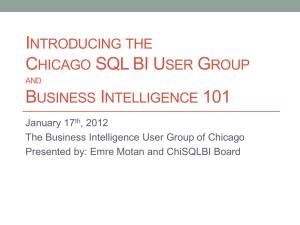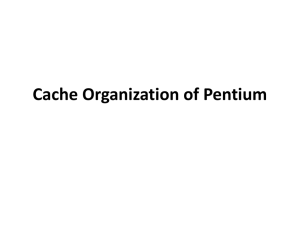DB2 Statement Cache in a Nutshell
advertisement
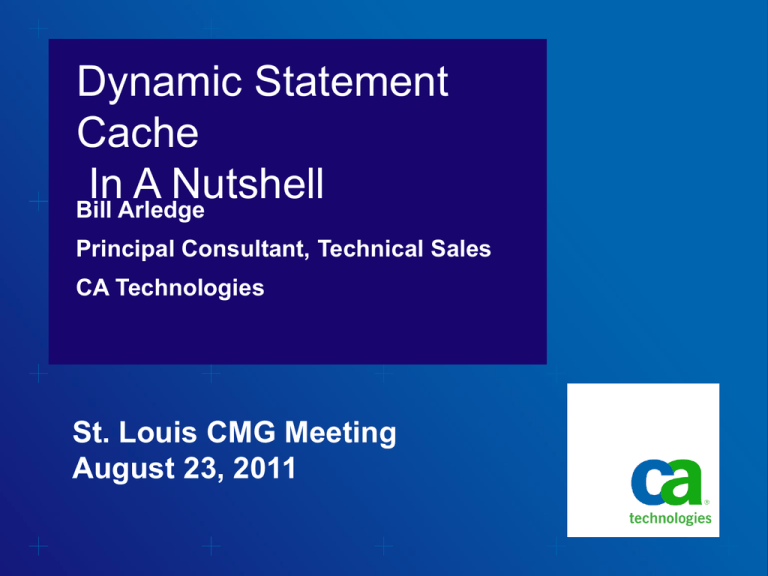
Dynamic Statement Cache In A Nutshell Bill Arledge Principal Consultant, Technical Sales CA Technologies St. Louis CMG Meeting August 23, 2011 What Will We Talk About? — Some SQL Tuning Fundamentals — Dynamic SQL in More Detail — Introduction to DB2 Statement Caching — Mining for Gold in the Global Statement Cache SQL Tuning Fundamentals DB2 Optimizer Determines SQL Performance (Initial SQL Statement Text DB2 Configuration Hardware Configuration OPTIMIZER TABLE Schema Definitions Catalog Statistics Tablespace DB04.TS1 Index App1.Index1 Access Path To the Data SQL Tuning Fundamentals Access Path Selection Static SQL › Access path determined at bind time – better performance For Dynamic SQL › Access Path Selection determined at execution – Exceptions to the rule – That’s the PREPARE – Exceptions to the Rule • KEEPDYNAMIC bind option • REOPT (VARS) or (ALWAYS) – Access path determined at run time for those statements with host variables or parameter markers – Holds prepared statements across commits to avoid cost of re-preparing statement • PREPARE(DEFER) – Option useful in distributed environments for reducing message traffic › Authorization for execution at the plan/package level › Qualifiers passed via host variables › SQLJ provides for bound static SQL in Java applications DB2 Configuration Hardware Configuration • Global Dynamic Statement Cache – Maintains Skeleton of prepared statements › Build and execute SQL on the fly › User requires authorization to all accessed › objects Parameter markers for passing variables SQL Statement Text OPTIMIZER TABLE Schema Definitions Catalog Statistics Tablespace Index App1.Index1 DB04.TS1 Access Path To the Data Trends in the Marketplace Static vs. Dynamic SQL —Dynamic SQL is > 50% of the workload at many shops —What’s drives dynamic SQL usage? − Dynamic SQL offers flexibility that can simplify developing complex applications − New applications being developed on distributed platforms using connections that only support dynamic SQL • DB2 CONNECT, etc. − ERP applications implemented with dynamic SQL • SAP, PeopleSoft, Siebel − New applications being developed on distributed platforms • New developers are much more familiar with GUI and/or web-based programming environments and don’t even sign on to the mainframe –More Java and C++ SQL Fundamentals - Static SQL CURSOR Processing — Data access requirements well defined and predictable – Define the Cursor Host variable defined In working storage – Open the cursor – Fetch the rows from the result set – Close the cursor SQL Fundamentals - Dynamic SQL — Data access requirements are ad hoc in nature and identified on the fly − SELECT Operations Parameter marker provides placeholder for later substitution At Cursor OPEN the variable value will be substituted Dynamic SQL Considerations The PREPARE › Repeated PREPAREs drive up the cost of dynamic SQL – Prepared statements by default are not persistent across UOWs – Prepare costs vary widely but are significant › Key requirement from anyone developing dynamic SQL applications to reduce or eliminate the cost of preparing dynamic SQL statements – Driven initially by SAP and other ERP vendors – More in-house dynamic SQL applications drive this requirement › Enter Dynamic Statement Caching Introduction to Dynamic Statement Caching › Goal is to reduce or eliminate SQL Prepare operations required for dynamic SQL statements › Implementation – Four kinds of caching • • • • No caching Local Dynamic Statement Caching Global Dynamic Statement Caching Full Caching – Cache prepared SQL statement and statement text for dynamic SQL statements in DBM1address space • Local Statement Cache • Global Dynamic Statement Cache – Controlled by various parameters • Bind options • DSNZPARMs • Application constructs Dynamic Statement Caching No Statement Caching — Prepared statements do not persist across commits − Discarded at commit − Except for statements defined with CURSOR for HOLD — Default mode of operation − Full Prepare has a high cost Program RRS01 Thread Storage Prepared Statement STMT2(Version 1) Prepared Statement STMT2(Version 2) •No prepare returns -514 or -518 Dynamic Statement Caching Global Statement Caching — Allows reuse of prepared statements across UOWs − Within and across program executions − Prepared statement (SKDS) cached in global dynamic statement cache • Copied into local storage when possible • Short Prepare — Enabling global statement caching − CACHEDYN=YES DSNZPARM value − Storage allocation discussed later — Big benefit for applications with frequent reuse of dynamic SQL − Benefits with no coding changes required Program RRS01 RRS01 Local Thread Storage Prepared Statement STMT2(Version 1) SKDS SKDS Global Statement Cache Program RRS01 SKDS Prepared Statement STMT2(Version 1) RRS01 Local Thread Storage Dynamic Statement Caching Where Cached Statements can be Reused —Statement text must be 100% the same −Use parameter markers −Literals won’t work (usually) —Additional items must be 100% the same or compatible − Bind rules −Special registers −Authorizations −Others —You may not get any benefit out of the dynamic statement cache at all −Most likely to benefit if you using an ERP or some other application that uses dynamic SQL extensively Dynamic Statement Caching Prepare Costs — Full Prepare − Statement not in cache − Global statement caching not active — Short Prepare − Dynamic statement (SKDS) in the global cache − Global caching active — Avoided Prepare − Local and global caching active Dynamic Statement Caching EDM Pool in DB2 9 DBM1 – Database Services Address Space DBDPOOL DBDs DBDs SKCT SKPT CT PT GLOBAL STATEMENT CACHE SKDS EDMPOOL ›Portions of runtime components EDMPOOL SKDS CT SKDS PT moved above the bar –Plan and package skeletons above the bar – Bound/Prepared DML Statements • Statement Text • SQLDA DESCRIBE output • Portion of native SQL PL package – Portions of static SQL sections 2GB Bar (CT/PT) are moved as well ›Further reduces VSC in the DBM1 address space ›Constraints still exist Dynamic Statement Caching EDM Pool in DB2 10 DBM1 – Database Services Address Space DBDPOOL DBDs ›Portions of runtime components EDMPOOL DBDs SKCT SKPT CT PT GLOBAL STATEMENT CACHE SKDS SKDS SKDS EDMPOOL Minimal thread storage moved above the bar –Plan and package skeletons above the bar – Bound/Prepared DML Statements • Statement Text • SQLDA DESCRIBE output • Portion of native SQL PL package – Portions of static SQL sections 2GB Bar (CT/PT) are moved as well ›Virtual eliminates VSC in the DBM1 address space ›90 % of thread storage now above the 2GB bar Dynamic SQL Statement Caching DB2 Cache Statistics (from the DB2 Statistics record) Requested statement was found in cache (nearly best case) • Short Prepare • Higher the better Statement Not In Cache (worst case) • Full prepare • Should be low depending on dynamic workload Prepare Avoided Specific for Applications bound with KEEPDYNAMIC(YES) • High is good Statement Discarded Shoot for 0 Increase MAXKEEPD if > 0 The Global Dynamic Statement Cache More Details — Dynamic Statements − Inserted in the cache if: • CACHEDYN=YES – Global Cache is active — Bind Options Impact on the cache − REOPT ALWAYS – prepared statements aren’t placed in the cache − REOPT ONCE - Prepares the statement the first time the statement is executed with host variables available at that time − REOPT AUTO – DB2 9 feature where DB2 will examine the host variable values and will generate new access paths only when host variable values change and DB2 has not already generated an access path for those values − REOPT NONE – DB2 will not re-optimize the SQL at run time — Cached statements reside in the cache until: • • • • DROP or ALTER of any object Authorization Revoked LRU - Least Recently Used RUNSTATS Retrieving Data From the Global Cache — As shown previously − Statement caching performance data in DB2 statistics records − Metrics show details about cache hit ratios and other useful data points that help you evaluate overall performance of your statement caches — For more detail on Global Statement Cache usage the following instrumentation is provided − IFCID 316 – Provides details on statements in the cache • First 60 bytes of SQL text • Includes execution statistics (0 if not being collected) − IFCID 317 can then be used to retrieve the entire SQL statement from the cache once you have identified the statement of interest — EXPLAIN STMTCACHE − V8 feature that exports Dynamic Statement Cache information to the DSN_STATEMENT_CACHE_TABLE − Nearly identical to the detail in IFCID 316 & 317 − Multiple options including ALL, stmt-id, and stmt-token Reviewing Global Statement Cache Information IFCID 316 Results •First 60 Bytes of SQL Text IFCID 317 gives full text •Bind Options •Statement Statistics (more later) Reviewing Global Statement Cache Information IFCID 317 Results • IFCID 317 returns the full text of the SQL statement • Notice that the two statements are functionally equivalent but have different formatting • 2 statements in the cache Reviewing Global Statement Cache Information Literals vs. Parameter Markers • In this example we have multiple statements in the cache that are exactly the same except for the literals used in the statement • What’s the downside • No re-use of the prepared statement so more CPU • Other statements in the cache may be tossed out if many of these statements run in a given period of time DB2 10 Dynamic Statement Cache Enhancement — Literals vs. parameter marker issue mitigated using new CONCENTRATE STATEMENTS WITH LITERALS clause − Can be added to the PREPARE Statement − Can be set in JCC driver on the client side • enableliteralReplacement=‘YES’ − ODBC initialization file in z/OS can set LITERALREPLACEMENT — Sequence of events − Incoming SQL with literals is looked up in the cache (DB2 9 behavior) − If not found, literals are replaced and the new SQL is searched for − If not found, new SQL is prepared and stored in the cache. — Actual literals are stored in the cache as well Mining the Dynamic Statement Cache EXPLAINing the SQL — EXPLAIN STMTCACHE ALL − Inserts one row for each entry in the global DSC • Populates DSN_STATEMNT_CACHE_TABLE only • STMT_ID column matches the Unique ID in the global statement cache • Nearly exact match to the DSC with a few additional columns • COLLID set to DSNDYNAMICSQLCACHE — EXPLAIN STMTCACHE STMT_ID − Extracts a single statement from the global DSC • Populates PLAN, DSN_DYNAMIC_STATEMNT, DSN_STATEMENT, and DSN_FUNCTION tables if they exist • Access path is current access path for statement in the cache • Numeric literal or host variable from program — EXPLAIN STMTCACHE STMTTOKEN − Extracts a group of statements from the global DSC • Populates PLAN, DSN_DYNAMIC_STATEMNT, DSN_STATEMENT, and DSN_FUNCTION tables if they exist • Access path is current access path for statement in the cache • Based on STMT_TOKEN value in the cache • Alphanumeric literal or host variable in program Reviewing Global Statement Cache Information IFCID 318 › Execution statistics for › › › dynamic SQL statements Turn on collection with Monitor trace IFCID 318 – Begins collecting statistics and accumulates them for the length of time the monitor trace is on – Stop Monitor trace resets all statistics – 2-4% overhead per dynamic SQL statement stored in the cache Recommended approach – Run the trace only when actively monitoring the cache Use EXPLAIN STMTCACHE to externalize data for evaluation Summary — Dynamic SQL is a major part of many workloads − ERP Vendors − Distributed applications — DB2 offers multiple options for reducing the overhead traditionally associated with dynamic SQL — These options include multiple types of statement caching − Local statement caching − Global statement caching − Full statement caching — DB2 9 and 10 both introduced new functionality to enhance dynamic statement cache usage

